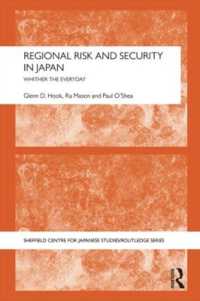- ホーム
- > 洋書
- > 英文書
- > Nature / Ecology
Full Description
Coordinated, well-functioning institutions are crucial for tackling environmental challenges like climate change, pollution, biodiversity loss, and resource overuse. This book presents case studies from around the world to showcase how different socio-political institutions interact to influence environmental management outcomes in complex, polycentric institutional settings. Collectively, the cases emphasize the importance of unpacking interactional complexity through an improved understanding of cross-scalar, cross-cultural, and cross-functional institutional interactions. By encouraging practitioners to reflect on these three dimensions, this book identifies key considerations for designing innovative institutional coordination mechanisms in support of sustainable environmental management.
Contents
Dedication. Foreword. Preface. Acknowledgements. 1. Introduction: The Increasing Relevance of Assessing Institutional Diversity in Sustainable Environmental Management. 2. Path-Dependent Pathways of Inter-Institutional Gaps in Natural Resource Management. 3. The Philippines' Neoliberal Extractive Industry: Mining for Development, State Violence, and Inter-Institutional Gaps in Resource Governance. 4. Tiger Conservation Governance in the Bangladesh Sundarbans: Identifying Inter-Institutional Gaps. 5. Applying an Access Lens to Understand Equity in a Polycentric Governance Regime: Why Rights Alone May be Insufficient to Advance Indigenous Fishery Development. 6. Institutional Change Between the RastafarI Movement and the Formal State in Jamaica: A Historical Perspective. 7. Diversity in Institutional Strategies for Distributed Renewable Energy Generation: How American States are Designing Net Metering Policy. 8. Necessary but Not Sufficient: An Examination of Two Areas of Multilateral Environmental Institutions. 9. Enabling and Bridging Institutional Diversity Through Polycentric Governance Structures to Advance Sustainable Development: The Case Study of the Arctic Council. 10. Concluding Remarks: Characterizing Institutional Diversity for Improved Sustainable Environmental Management. Index.








